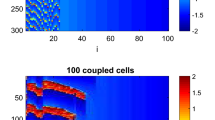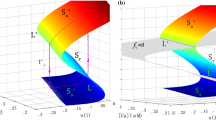Abstract
We study a recently discovered class of models for plateau bursting, inspired by models for endocrine pituitary cells. In contrast to classical models for fold-homoclinic (square-wave) bursting, the spikes of the active phase are not supported by limit cycles of the frozen fast subsystem, but are transient oscillations generated by unstable limit cycles emanating from a subcritical Hopf bifurcation around a stable steady state. Experimental time courses are suggestive of such fold-subHopf models because the spikes tend to be small and variable in amplitude; we call this pseudo-plateau bursting. We show here that distinct properties of the response to attempted resets from the silent phase to the active phase provide a clearer, qualitative criterion for choosing between the two classes of models. The fold-homoclinic class is characterized by induced active phases that increase towards the duration of the unperturbed active phase as resets are delivered later in the silent phase. For the fold-subHopf class of pseudo-plateau bursting, resetting is difficult and succeeds only in limited windows of the silent phase but, paradoxically, can dramatically exceed the native active phase duration.
Similar content being viewed by others
References
Baer, S.M., Rinzel, J., 1988. Threshold for repetitive activity for a slow stimulus ramp: a memory effect and its dependence on fluctuations. Biophys. J. 54(3), 551–555.
Bertram, R., Butte, M., Kiemel, T., Sherman, A., 1995. Topological and phenomenological classification of bursting oscillations. Bull. Math. Biol. 57, 413–439.
Butera, R. Jr., Rinzel, J., Smith, J.C., 1999. Models of respiratory rhythm generation in the pre-Bötzinger complex. I. Bursting pacemaker neurons. J. Neurophysiol. 82(1), 382–397.
Chay, T.R., Keizer, J., 1983. Minimal model for membrane oscillations in the pancreatic β-cell. Biophys. J. 42, 181–190.
Doedel, E., 1981. AUTO: A program for the automatic bifurcation analysis of autonomous systems. Cong. Num. 30, 265–284.
England, J.P., Krauskopf, B., Osinga, H.M., 2007. Computing two-dimensional global invariant manifolds in slow-fast systems. Int. J. Bifurc. Chaos 17(3), 805–822.
Ermentrout, B., 2002. Simulating, Analyzing, and Animating Dynamical Systems. SIAM, Philadelphia.
Golubitsky, M., Josic, K., Kaper, T.J., 2001. An unfolding theory approach to bursting in fast-slow systems. In: H. Broer, B. Krauskopf, G. Vegter (Eds.), Analysis of Dynamical Systems: Festschrift Dedicated to Floris Takens on the Occasion of his 60th Birthday, pp. 277–308. Institute of Physics, Bristol.
Izhikevich, E.M., 2000. Neural excitability, spiking, and bursting. Int. J. Bifurc. Chaos 10, 1171–1266.
Kinard, T.A., de Vries, G., Sherman, A., Satin, L.S., 1999. Modulation of the bursting properties of single mouse pancreatic β-cells by artificial conductances. Biophys. J. 76, 1423–1435.
Krauskopf, B., Osinga, H.M., 2003. Computing geodesic level sets on global (un)stable manifold of vector fields. SIAM J. Appl. Dyn. Syst. 2(4), 546–569.
Krauskopf, B., Osinga, H.M., Doedel, E.J., Henderson, M.E., Guckenheimer, J.M., Vladimirsky, A., Dellnitz, M., Junge, O., 2005. A survey of methods for computing (un)stable manifolds of vector fields. SIAM J. Appl. Dyn. Syst. 15(3), 763–791.
Kuryshev, Y.A., Childs, G.V., Ritchie, A.K., 1996. Corticotropin-releasing hormone stimulates Ca2+ entry through L- and P-type Ca2+ channels in rat corticotropes. Endocrinology 137(6), 2269–2277.
LeBeau, A.P., Robson, A.B., McKinnon, A.E., Sneyd, J., 1998. Analysis of a reduced model of corticotroph action potentials. J. Theor. Biol. 192, 319–339.
Lisman, J., 1997. Bursts as a unit of neural information: making unreliable synapses reliable. Trends Neurosci. 20(1), 38–43.
Phillips, M., Levy, S., Munzner, T., 1993. Geomview: an interactive geometry viewer. Not. Am. Math. Soc. 40, 985, http://www.geomview.org.
Rinzel, J., 1987. A formal classification of bursting mechanisms in excitable systems. In: E. Teramoto, M. Yamaguti (Eds.), Mathematical Topics in Population Biology, Morphogenesis, and Neurosciences. Lecture Notes in Biomathematics, vol. 71, pp. 267–281. Springer, New York.
Sherman, A., Rinzel, J., Keizer, J., 1988. Emergence of organized bursting in clusters of pancreatic β-cells by channel sharing. Biophys. J. 54, 411–425.
Stojilkovic, S.S., Zemkova, H., van Goor, F., 2005. Biophysical basis of pituitary cell type-specific Ca2+ signaling-secretion coupling. Trends Endocrinol. Metab. 16(4), 152–159.
Tabak, J., Senn, W., O’Donovan, M.J., Rinzel, J., 2000. Modeling of spontaneous activity in developing spinal cord using activity-dependent depression in an excitatory network. J. Neurosci. 20(8), 3041–3056.
Tabak, J., Toporikova, N., Freeman, M.E., Bertram, R., 2007. Low dose of dopamine may stimulate prolactin secretion by increasing fast potassium currents. J. Comput. Neurosci. Epub. Ahead of print DOI 10.1007/s10,827-006-0008-4.
Terman, D., 1991. Chaotic spikes arising from a model of bursting in excitable membranes. SIAM J. Appl. Math. 51, 1418–1450.
Tsaneva-Atanasova, K., Sherman, A., van Goor, F., Stojilkovic, S.S., 2007. Mechanism of spontaneous and receptor-controlled electrical activity in pituitary somatotrophs. J. Neurophysiol. 98(1), 131–144.
van Goor, F., Li, Y.X., Stojilkovic, S., 2001. Paradoxical role of large-conductance calcium-activated K+ (BK) channels in controlling action potential-driven Ca2+ entry in anterior pituitary cells. J. Neurosci. 21, 5902–5915.
Author information
Authors and Affiliations
Corresponding author
Additional information
J.V. Stern and H.M. Osinga contributed equally.
Rights and permissions
About this article
Cite this article
Stern, J.V., Osinga, H.M., LeBeau, A. et al. Resetting Behavior in a Model of Bursting in Secretory Pituitary Cells: Distinguishing Plateaus from Pseudo-Plateaus. Bull. Math. Biol. 70, 68–88 (2008). https://doi.org/10.1007/s11538-007-9241-x
Received:
Accepted:
Published:
Issue Date:
DOI: https://doi.org/10.1007/s11538-007-9241-x




